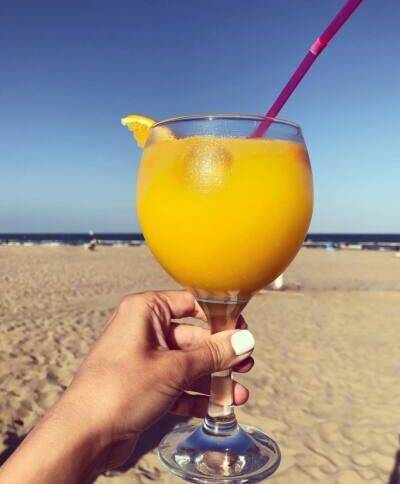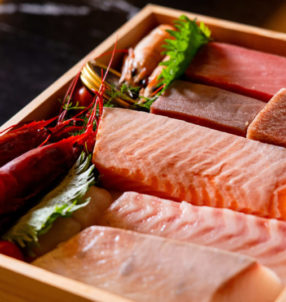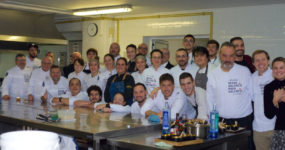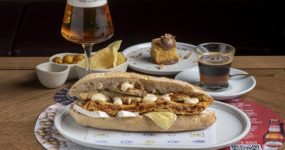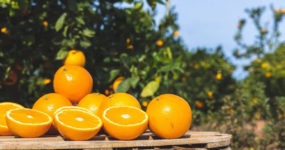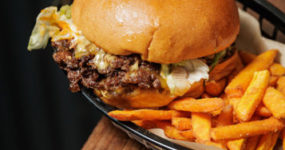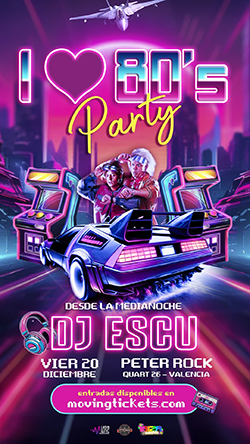##Agua de Valencia was first concocted by erstwhile artist and barman Constante Gil, who started serving it in his bar, the now sadly defunct ‘Cerveceria Madrid’ in C/ Abadia San Martin in 1959 in Valencia. The bar with its live piano music and its alcoves and poky corners was a classic of Valencian nightlife, especially through the years of the ‘transition’ to democracy and up until the mid-nineties. Its walls were decorated with Constante’s collection of impressionist paintings ‘Tertulias de Café’ that invariably depicticted people sitting around a table enjoying a jar of the famous cocktail. A few years ago, the bar reopened as ‘Café Madrid’ and still retains some of the bar’s distinctive paintings and they still serve ‘Agua de Valencia.’
So the story goes, a group of Basque salesmen who were regular visitors to Valencia, staying in the nearby Hotel Bristol, would spend their evenings in Constante’s bar and would always order the best house Cava, jokingly calling it ‘Agua de Bilbao’ in honour of their homeland. “In Bilbao, the water is as good as this” they would tell him. One evening, getting a bit tired of their banter, Constante said he would surprise them with something a bit different and that’s how he came up with ‘Agua de Valencia’… a mix of fresh orange juice, white spirits and cava.
In the dark & lonely nights of Franco’s sixties, like the rest of Spain, nightlife hadn’t really taken off in a big way in Valencia. Constante was offering his mixture to customers every evening in his bar but few people had heard of it in other parts of the city. It wasn’t until the seventies when the tired old regime was starting to be openly challenged. Groups of beardy Che Guevara wannabe students known at the time as “Progres” would frequent bars like Cerveceria Madrid to smoke too many Ducados and talk politics. As the Universities were almost perpetually on strike, these largely middle-class revolutionaries had time on their hands to kick-start Valencian nightlife and what was the first obvious signs of a Valencian youth culture.
One of their favourite drinks was Agua de Valencia. It seemed to tick all the boxes. Girls liked it, its name chimed with their political struggle for autonomy, it had a hint of elegance, something more intellectual and sophisticated than beer, it was cheap and it got you drunk. Here was a perfect cocktail for lefties and artistic types, to be drunk while listening to the music of Maria del Mar Bonet or Raimon.
By the 1980s, Agua de Valencia had become THE drink of the Valencia scene. It was especially popular amongst students as, just like its bastard son, the Cubalitro and the present day Botellón drinking in the street, it was made for sharing. In those days it was relatively inexpensive. You would order a jug and enough glasses for everyone. Agua de Valencia was available in the dozens of new bars opening up in the Carmen and had quickly spread to other up-and-coming areas of the city like Xuquer, Ciudad Jardin, Cánovas and Juan Llorens.
As often happens with these things, it was the widespread popularity of Agua de Valencia, which finally led to its downfall. Mass sales meant a drop in quality, especially in the spirits used to mix the drink. Freshly squeezed orange juice was increasingly replaced by bottled juice. The centre of the whole ‘Agua de Valencia’ scene had moved to the then extremely popular Café de Paris in the town centre, which also had a branch on C/Manuel Candela. Café Paris had a long list of ‘Aguas’ from anywhere you can think of; Agua de Dublín, Agua de Londres, Agua de Estambul, Agua de Milan even, for some reason, Agua de Leeds. Each of these was a different colour, with impossible combinations of cordials and low-quality alcohol which were to blame for many a Sunday morning bad head in the late eighties and early nineties. Much to the horror of most Valencianos, Agua de Valencia was even bottled and sold in supermarkets. The drink’s popularity had reached its peak and suddenly, during the end of the nineties, it fell out of fashion.
Hector, the owner of La Salamandra, a small bar with a wonderfully welcoming and relaxed atmosphere and a large terrace on a popular corner of Plaza Xuquer, has been a witness to the comings and goings of Valencian nightlife over the last thirty years. He believes that it was mass production that nearly killed Agua de Valencia off: “People realized it was getting more and more expensive and because the bars weren’t taking any care in its preparation and ingredients, it didn’t seem to taste very good anymore. Agua de Valencia is freshly squeezed oranges with the right mix of spirits and half-decent cava, the bars weren’t providing that, and don’t get me started on that bottled stuff they sell to tourists” says Hector.
The drink is still popular in his bar, mostly drunk by couples. For Hector it is important to get the mix right and, according to him, the proportions just don’t work in a big one or two-litre beer jug: “It’s a social drink, but it should only be served in small jugs for two people, if you want more then I’ll make you a fresh jug.” A true purist, he prefers to do the job properly or not at all, he even says if the oranges aren’t sweet enough, it’s not worth making it: “Adding sugar to sweeten the orange juice just shouldn’t be an option”.
The area of the city most associated with Agua de Valencia is the Barrio del Carmen and if you are only going to try it once, it ought to be in a place like Café San Jaume on C/ Caballeros or Radio City on C/ Santa Teresa or ‘La Cava del Negret’ on Plaza Negrito. They are three of the area’s longest standing bars, which typify the old “barrio” and the first two have strong claims to have been making and selling Agua de Valencia longer than any other bar in the city. Even though demand isn’t what it was in its heyday, they still get through plenty of jugs of the drink.
According to the people at San Jaume: “A lot of tourists who have found the bar in a guide or on the Internet come to our place especially to order Agua de Valencia. There are local people who’ve been coming back here regularly since the very beginning to enjoy the odd glass. Also couples often order it or mixed groups of men and women. Men on their own, for example, don’t usually order it and, these days; it’s not a cheap drink, so it’s not so popular with younger customers who can get two or three beers for the price of a glass”.
In the Barrio de Ruzafa a classic place for Agua de Valencia is Cafè Tocado in C/Cadiz, a bar in the heart of the area with live music and theatre whose decoration puts you in mind of a “cabaret” from the ‘La Belle Epoque’. Like all the classic Agua de Valencia bars we’ve mentioned, they go for quality ingredients but this being Ruzafa, unlike the bars in the centre, they don’t attract so many tourists. They told us that although it is still a staple, other drinks have replaced Agua de Valencia in popularity: “It’s normally drunk by groups and couples, usually people over thirty, these days younger people tend to go for more fashionable drinks like caipirinhas or mojitos. Having said that the drink is a classic, we’ve always served it and it’s always been in demand.”
So how do you make it? Every bar does it their own way; some add cava and some don’t. Most places keep the exact recipe to themselves but we did pick up a few tips. Anywhere worth its salt will use freshly squeezed orange juice with sweet oranges, so sugar is not necessary, plus a mixture of good quality white spirits. We were also told never to use orange-flavoured liqueurs like Cointreau or Curacao, as they don’t blend well with the orange juice.
David Rhead and José Marín
Article copyright ’24/7 Valencia’
The Official ‘24/7’ Agua de Valencia Recipe
Mix: Two parts freshly squeezed chilled sweet oranges
Seven parts chilled cava. (brut or semi-seco depending on taste).
One part mixture of good quality vodka and gin.
In a pint jug and serve in saucer champagne glasses.


